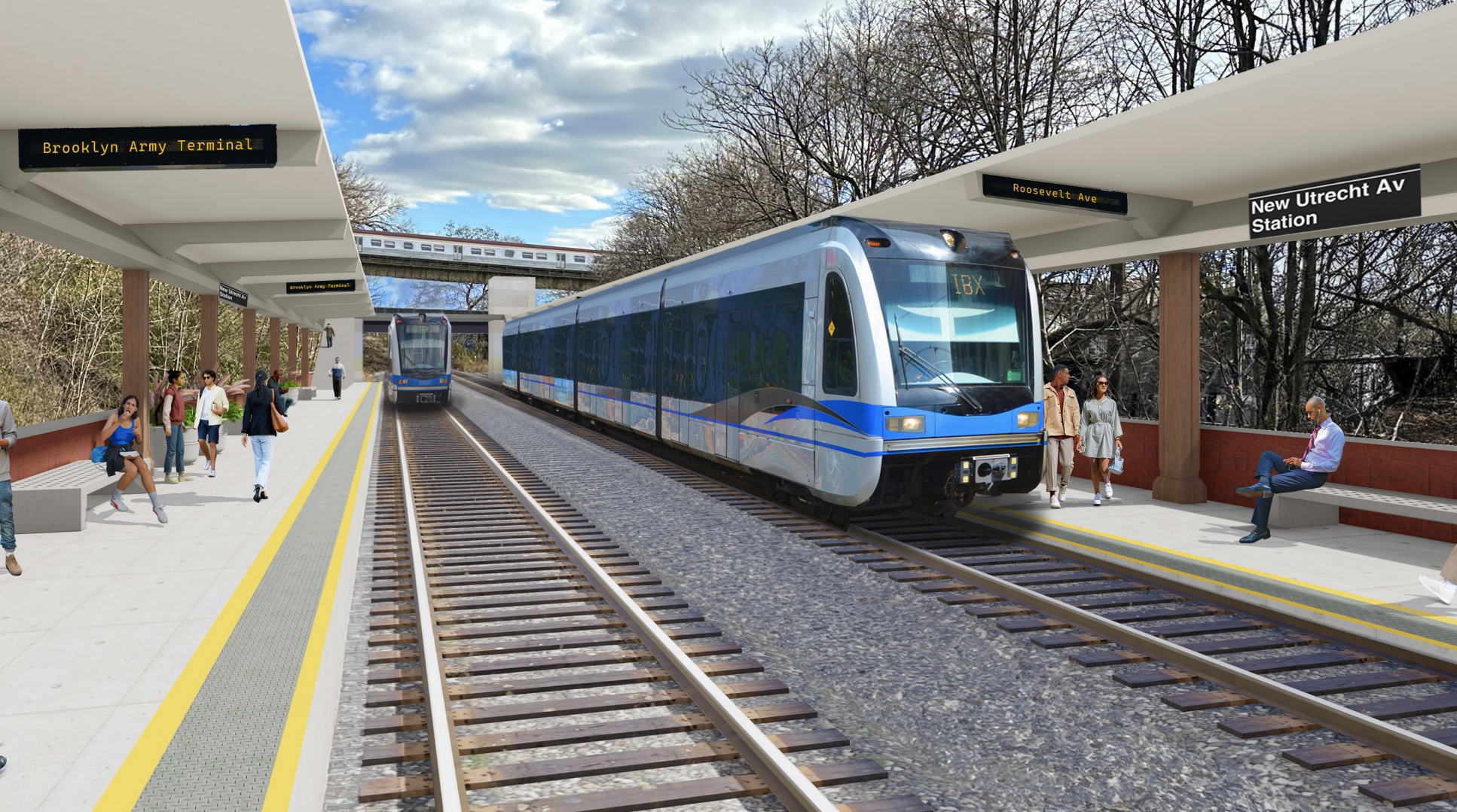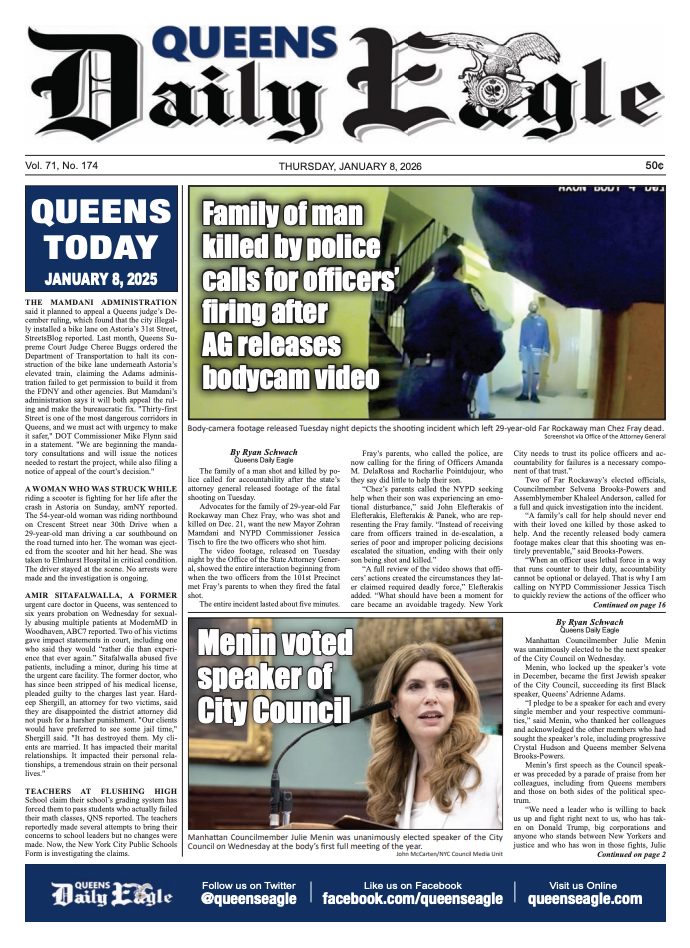MTA says it wants to kickstart IBX – but funding questions remain
/The MTA on Wednesday proposed allocating $2.75 billion to kickstart the ambitious Interborough Express, a light rail that would run 14 miles from Jackson Heights to Bay Ridge. Rendering via the MTA
By Jacob Kaye
Metropolitan Transit Authority officials proposed Wednesday allocating over $2 billion to pay for the first steps needed to build the Interborough Express, a 14-mile light rail that would connect Queens to Brooklyn.
Unveiling their $68.4 billion 2025-2029 capital budget proposal from Corona, the officials said they hoped to put $2.75 billion toward the design and engineering of the IBX, which was first pitched by Governor Kathy Hochul in 2022. The proposed funding for the ambitious new transit line, which would mostly run along an existing freight route from Jackson Heights to Bay Ridge, would cover around half of the project’s estimated $5.5 billion price tag.
“The MTA is ready to deliver the [IBX] efficiently, on time and on budget,” the MTA’s proposed capital spending plan read.
The proposed funding would allow the MTA to complete its environmental review of the IBX, as well as its design and preliminary engineering for the project. Should the funding be approved, a portion would be used to begin actual construction of the much-needed connector between the two boroughs.
At least for now, the proposed funding puts to rest worries that the governor’s controversial pause of the Central Business District Tolling program – otherwise known as congestion pricing – would dramatically delay the IBX, the governor’s first signature transit proposal.
The MTA was forced to postpone a number of expansion projects funded in its 2020-2024 capital spending plan earlier this year following the indefinite pause of congestion pricing, which would have brought in over $15 billion in toll revenue for the agency to spend on upgrades to its sprawling transit system. The MTA initially said that those delayed projects, including the extension of the Second Avenue subway line into Harlem, would be pushed to the 2025-2029 capital budget, a move that would, in turn, push back projects previously slated for that budget, including the IBX.
However, the IBX – which was always expected to be the crown jewel of the 2025-2029 spending plan – is the only expansion project included in the MTA’s proposal.
The governor has yet to detail how she plans to cover the $16.5 billion budget hole in the MTA’s 2020-2024 capital spending plan created by the pause on congestion pricing.
Though the budget unveiled Wednesday is only the first step in the MTA’s capital budget process, it indicates that, at the very least, the MTA is hoping to move the IBX forward.
Queens Borough President Donovan Richards told the Eagle in a statement that he was glad to see the IBX’s funding allocation in the MTA’s proposed capital plan.
“As I have said from the project’s inception, the Interborough Express will be a game changer, a job creator and a transformational time saver for Western and Southwest Queens families, many of whom live in transit deserts,” Richards said. “It’s exactly the kind of innovative mass transit project both Queens and Brooklyn need.”
“Improving outerborough transit must continue to be a top priority, and I look forward to working alongside Governor Hochul, the MTA and all our government and community partners to ensure the Interborough Express is nothing short of a massive victory for our borough and city,” he added.
As proposed, the IBX would serve nearly 1 million riders and connect to 17 subway lines. The line, which would begin at the Roosevelt Avenue station in Jackson Heights, would make 19 stops in total, hitting neighborhoods like Elmhurst, Maspeth, Middle Village, and Ridgewood in Queens, and Bushwick, Brownsville, Flatbush and Borough Park in Brooklyn. From end to end, the ride would take approximately 40 minutes.
In January 2023, the MTA announced that it had chosen to turn the infrequently-used freight line into a light-rail line, citing cost benefits and engineering problems that would have arisen had the agency decided to make the line a traditional subway route.
In the state’s Fiscal Year 2025 budget passed earlier this year, the governor and legislature allocated $52 million for the design and engineering of the IBX, which is currently undergoing an environmental review.
The project also saw a financial boost in June when U.S. Senator Chuck Schumer announced that the MTA would be the recipient of a $15 million federal grant, meant to be spent on kickstarting the IBX.
However, the $2.75 billion proposed by the MTA for the project on Wednesday would mark the largest investment made in the IBX thus far.
But whether or not the project is ultimately funded is a question that now rests with the legislature and the governor, who will together decide how – and how much – to fund the MTA’s proposed budget.
“They're the decision makers ultimately about how to put the funding package together,” MTA Chair and CEO Janno Lieber said on Wednesday.
Only a fraction of the proposed spending plan currently has identified funding streams, while the state will be responsible for figuring out how to fund at least $48 billion of the plan.
When asked about the governor’s support of the funding allocated to the IBX, a spokesperson for the governor provided the Eagle with a statement from Hochul about her past support for public transit projects, including “the Second Avenue Subway and rescuing the MTA from the ‘fiscal cliff’ last year.”
“We will review the MTA’s proposal for the upcoming 5-year capital plan and fight to secure as much funding as possible,” the governor said in a statement. “That includes pressuring Washington to deliver additional infrastructure dollars and working with our partners in the legislature and City Hall to determine priorities and capacity during the upcoming budget negotiations.”
The vast majority of the proposed spending in the plan would go toward preventing the MTA’s transit system, which includes the city’s subways, buses and the Metro-North and Long Island Rail Road commuter rails from falling into disrepair.
Nearly $11 billion of the proposed spending would go toward replacing 2,000 rail cars – 1,500 subway cars and 500 railroad cars.
Around $7 billion in funding would go toward accessibility upgrades at a little more than 60 subway stations – a number of accessibility projects were put on hold earlier this year following the congestion pricing pause. Should the funding be approved, the plan would make half of the city’s subway stations accessible, and keep the city on track to make 95 percent of its stations accessible by 2055, as required by law.
The MTA also proposed allocating $8 billion for general station improvements, which would include rebuilding 28 railroad stations and making repairs at a third of the MTA’s subway stations.
The proposed budget also includes plans to install new turnstiles in subway stations in an effort to prevent fare evasion, and plans to update power systems and signaling technology along a number of subway lines.




